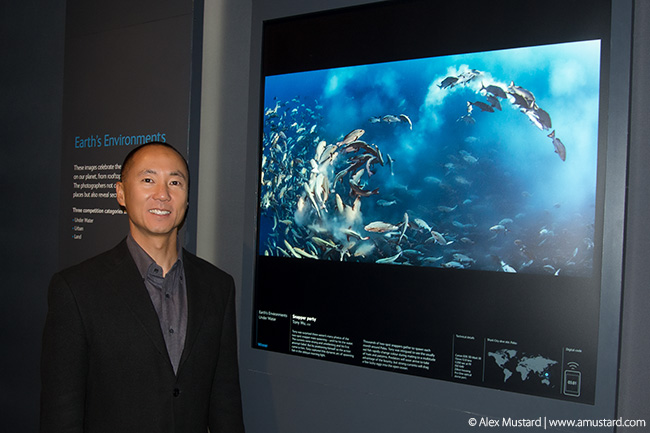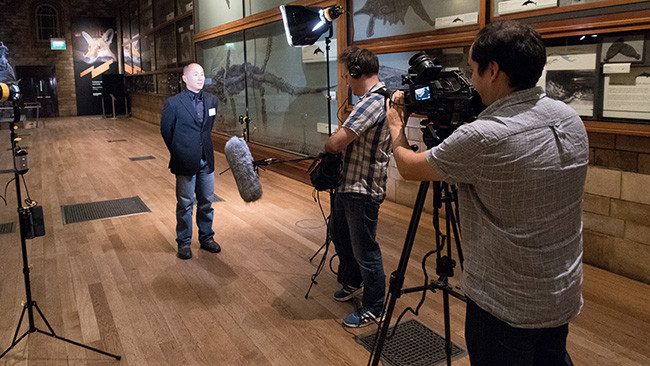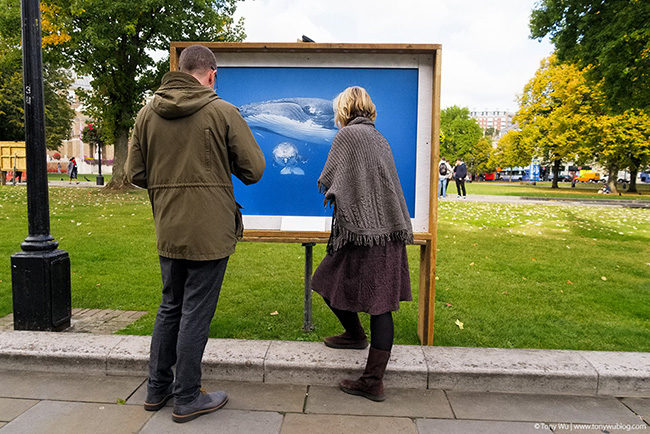I am on a plane (again), having just departed London, where I received first prize in the underwater category of the 52nd Wildlife Photographer of the Year award (#WPY52) organized by the Natural History Museum in London. It was my second time receiving this award (see 2010 photo). The sponsor this year was DONG Energy, whose generous financial support helped make the contest possible.
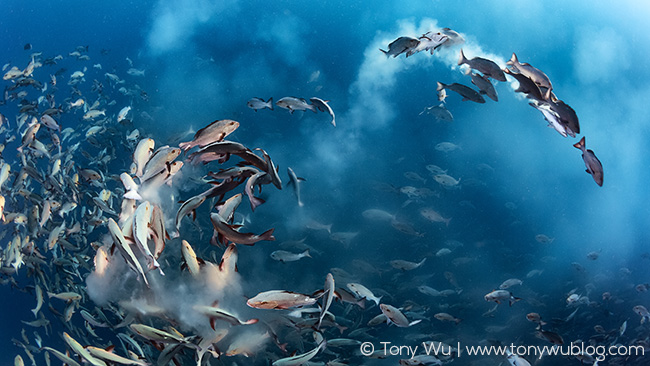
The awards dinner and presentation took place the night of 18 October at the Natural History Museum, a venue that in many ways defines the discipline of natural history. The grand atrium, the elegant corridors, the detailed displays are all imbued with a rich and longstanding tradition of research, learning, dedication, leadership. To my mind, there is no comparable setting.
The event was a black-tie affair, though tolerance was afforded to male photographers like me without tuxedos, so long as we cleaned up nicely and looked presentable. I did the best I could.
Host Liz Bonnin introduced each category, showing the finalists’ images on the big screen behind her, and then announcing category winners. Selected photographers went on stage to receive recognition. We were given the opportunity to share a few thoughts with the gathering of distinguished guests.
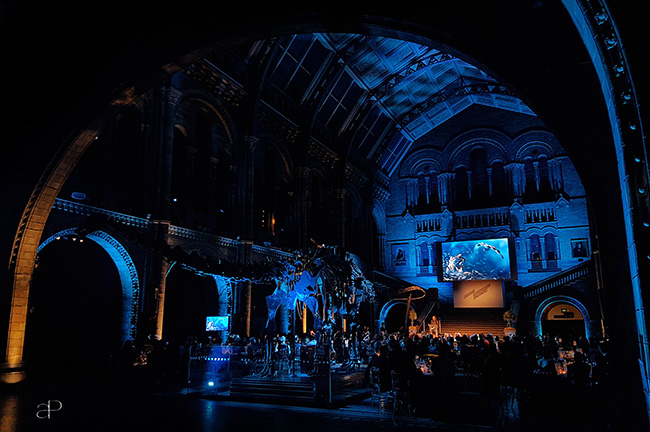
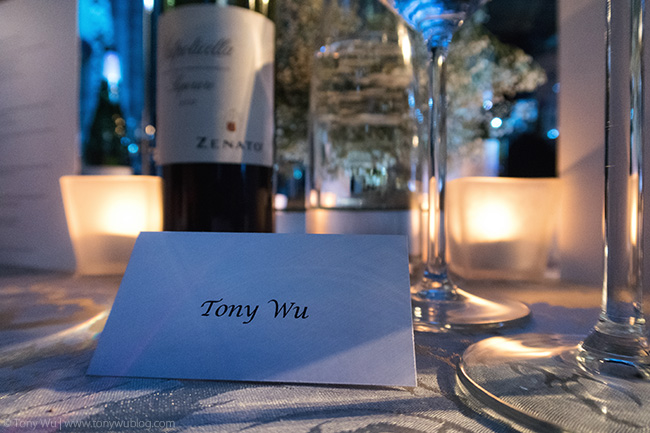
When my turn came, I was still mulling over what to say as I shook Liz’s hand.
The angel sitting on one shoulder advised: “Be a good boy. Explain why the world needs to care about fish spawning aggregations, thank everyone, and sit down.”
But the mischievous gremlin on my other shoulder won out.
I stood at the lectern, looked at my peers and judges, and said: “I never actually thought I would receive an award for a photo of group sex.”
Yup. At a formal banquet in the hallowed halls of the venerated Natural History Museum. Bad boy. Bad, bad boy.
In my defence, I got everyone’s attention. Many laughs as well. I even heard a snort worthy of a wallowing warthog.
I used that window of opportunity to deliver my message.
In short…Spawning aggregations comprising thousands of fish are among the most spectacular events in the natural world. Yet they remain, for the most part, unseen, undocumented, unknown, even to a well-educated, well-informed audience such as the one assembled that evening. Many aggregations have been targeted and taken, which is a formula for localised overfishing, sometimes population collapse. Healthy aggregations that still remain are such a tempting target that they need to be studied and protected.
I returned to my seat, uncertain of whether I’d ever be permitted back. C’est la vie.
Fortunately(?), Agorastos Papatsanis (finalist in the Black and White category) recorded the moment on video:
[video src="http://www.tonywublog.com/assets/images/2016/10/wpy52-201610-Tony-Wu-Agorastos-Papatsanis.mp4"]
The other category winners were all terrific. I particularly enjoyed the acceptance speeches given by Luis Javier Sandoval and Rudi Sebastian. They were humorous and entertaining.
Tim Laman was named the overall winner this year, for his vertigo-inducing(!) image of an orangutan climbing a gigantic fig tree. Tim has been working for at least 20 years to get that photo. It is a fantastic image, a testament to his hard work and dedication, and a symbol of hope for animals and ecosystems that have suffered the ceaseless encroachment of civilisation.
I’d met Tim before, but #WPY52 and Wildscreen (which I’ll say more about below) gave me an opportunity to spend some quality time with him.
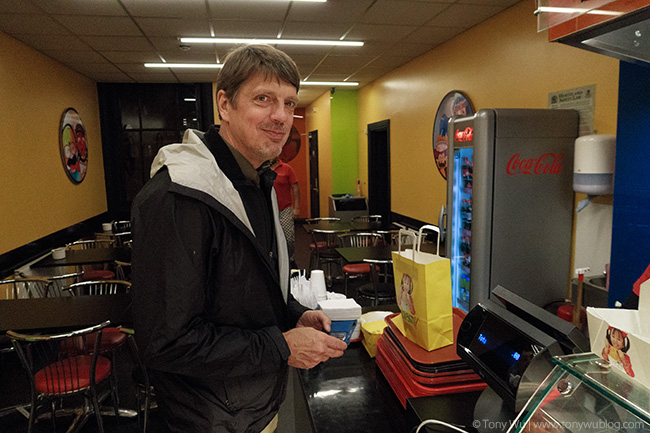
What a wonderful person he is.
I mean that both in the sense that he’s a fun, well-adjusted human being, and also in the context of nature photography.
Tim embodies that which I believe should be the primary, if not only, reason one should wield a camera in nature. He loves, truly loves, his subjects.
He has, for example, dedicated much of his life to learning about and sharing insights into the lives of orangutans. He devotes months each year to living among the wild primates. He shares these experiences with his wife, who is a researcher, and with his kids, who arguably have had the coolest kind of childhood possible.
What I’m getting at is that Tim doesn’t take photos for recognition. It’s not about glory; it’s not about getting Likes or hearts or whatever. It’s about the animals. The environment. The future of our world.
And that is a trait common among the talented photographers I met while in the UK, from bright-eyed, eager children to field-tested veterans. That, perhaps, is what I enjoyed the most about #WPY52. That is what energised me for the struggles and hard work that lie ahead.
One thing I wanted to highlight when I was on stage but wasn’t able to is that many photos and stories are team efforts.
In the case of my fish orgy picture, for instance, Clayton Johannes (Blue Marlin), Paul Collins, Richard Barnden (both Sam’s Tours/ Unique Diving Expeditions), and many other people were instrumental. Without them, I literally would not have been able to succeed.
There are also the many friends who’ve traveled with and endured me, both to experience the aggregations and to support my efforts. Thank you!
And when I’m eventually ready to tell this fish tale to a wider audience, there will be photo editors, writing editors, science advisers, etc. Many of the world’s best, in fact, were in attendance at #WPY52.
Just before the event, I had an opportunity to do a Facebook Live chat with Bertie Gregory, host of NatGeo Wild’s digital series Wild_Life. Bertie interviewed me, Sam Hobson and Jen Guyton, asking partly planned, partly extemporaneous questions about our respective specialties and studies.
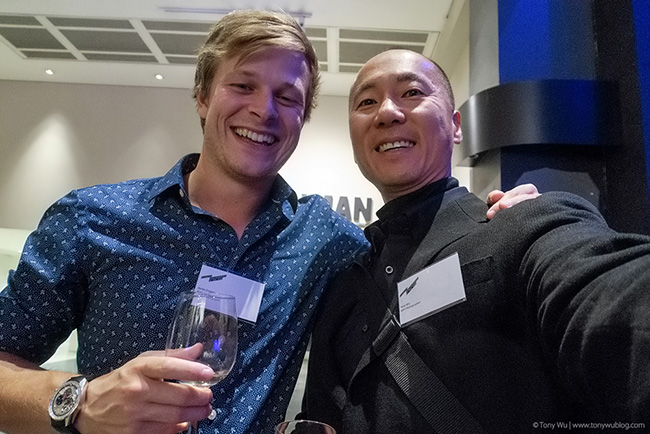
The highlight for me was teaching Bertie how to speak English. Someone has to do it.
It’s a long story, but essentially, a non-native speaker of English (that’s me) had to school a native speaker (that’s Bertie) on the proper pronunciation and etymology of the word diplodocus, topical because our Facebook Live broadcast was from the main hall of the Natural History Museum, where the 26m skeleton of a diplodocus now stands. It will soon be replaced by that of a blue whale (which means I really hope the organisers are kind enough to forgive my verbal indiscretion and allow me back at some point!).
I look forward to tutoring young Bertie again in the future. Perhaps I’ll be ambitious and attempt to tackle binomial appellations like Balaenoptera musculus with him. I dunno if he can handle two consecutive multisyllabic terms though (just teasing Bertie!)
I suppose the one thing #WPY52 really brought to mind is the value of friendships. Besides having the opportunity to see photographers I haven’t seen in ages, like Alex Mustard and Constantinos Petrinos (whose son Leon was a finalist in the 11–14 Years Old category), and to become friends with many more like-minded photographers, this event gave me an excuse to see one good friend in particular.
Charlie and I studied together, learned a language together, got stupid-drunk together many times, flew across the globe to attend each other’s weddings, worked in the same industry together, and shared many other experiences. Our lives have taken us in different directions over the years, but somehow, our paths always intersect.
I’m getting to the age when I have to start facing the reality that anything can happen at any time. Charlie and I have been through a lot together over the past 30+ years. Hopefully we’ll both experience a lot more. Thank you Charlie, for flying around the world to share the evening.
Prior to #WPY52 I attended the Wildscreen Festival in Bristol (#WildscreenFest). The focus (excuse the pun) of that multi-day event is primarily on video documentaries, but there was a public photo display on the College Green, and a day of talks by photographers.
I attended inspiring presentations by Emanuele Biggi, Audun Rikardsen, Justin Gilligan, Nick Cobbing, Tim Laman, and Luke Massey. There were many more talks I wanted to hear, but wasn’t able to catch, either because I was speaking or because of other schedule conflicts.
There were a couple of standout moments for me at #WildscreenFest.
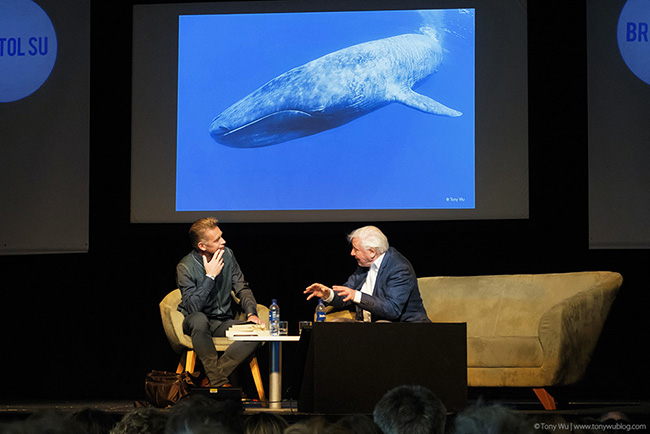
First was a talk by Sir David Attenborough and Chris Packham. One of my blue whale photos featured on screen toward the end of their chat. Like a starry-eyed teenager at a rock concert, I was hoping for a selfie with Sir David, but he departed right after the talk. Completely understandable when you take into consideration that he is 90 years old. But still. Bummer.
The amazing thing though, was that Sir David was as quick as a whip and as sharp as a tack. He delivered several unexpected and hysterical(!) jokes with impeccable timing, providing moments of much-appreciated levity, given the gravity of the pair’s discussion about the state of the natural world.
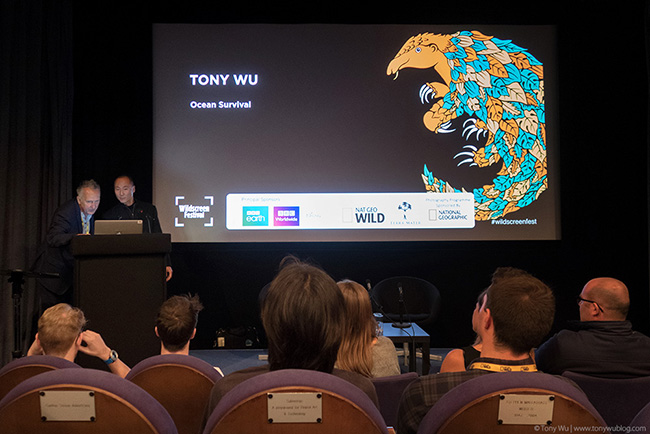
The second highlight was meeting Mark Carwardine. He is a man whose work I’ve looked up to for many years. I didn’t recognize him at first. I probably should have, as I’ve seen photos of Mark, but I’m kind of a dunce that way. I can often recognise a whale that I met years earlier, but when it comes to people…
Anyway, once I realised Mark was introducing my presentation, I conveyed my longstanding admiration for his work. Gentleman that he is, Mark said nice things about my photos. I then told him that Last Chance to See, a book he co-authored with Douglas Adams (of Hitchhiker's Guide to the Galaxy fame) is one of my all-time favourite books.
I concluded our first-ever conversation by telling Mark that I always remember him as the guy who got shagged by a kakapo (Strigops habroptilus) named Sirocco (an endangered, flightless parrot in New Zealand). If you haven’t seen this sequence in the BBC2 series called Last Chance to See, I've embedded a Youtube clip below. The X-rated action starts at around 40 seconds.
Watching a misguided bird direct his procreative urges at Mark's head never ceases to be funny.
It’s a good thing that British people have a good sense of humour. Mark is still talking to me. I think. Maybe not after reading this.
To conclude, I’d like to thank Wildscreen, the Natural History Museum, and the many good people in the UK who worked so hard to make both events successful. It was an honour and a pleasure to visit and participate.
I have another ten hours or so before I’m home. This will mark 13 days straight that I’ve had to wear shoes. How uncivilised. I can’t wait to go back to the sanity of flip-flops and fins.
If you’re in London, or planning to visit soon, I highly recommend seeing the #WPY52 exhibition. It is worth the price of admission. You probably have to wear shoes though. (Gallery of selected images)
